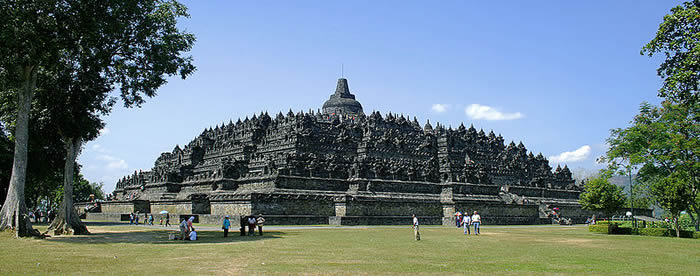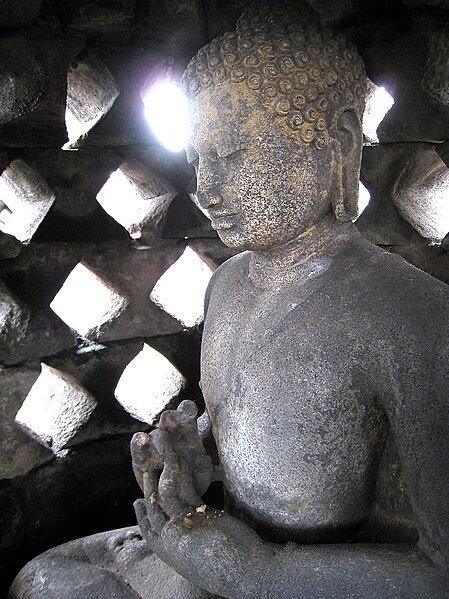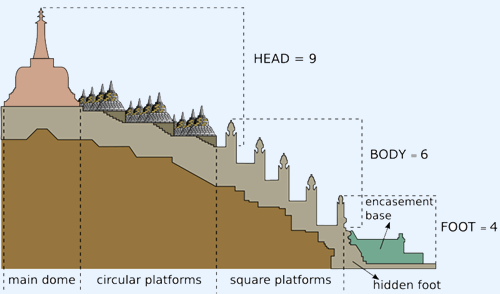Borobudur- Indonesia : One of the Largest Buddhist monuments with Video
| A nice and informative video on Borobudur By UNESCO |
Borobudur is one of the greatest Buddhist monuments in the world. Founded by a king of the Saliendra dynasty, it was built to honour the glory of both the Buddha and its founder, a true king Bodhisattva. The name Borobudur is believed to have been derived from the Sanskrit words vihara Buddha uhr, meaning the Buddhist monastery on the hill. Borobudur temple is located in Muntilan, Magelang, and is about 42 km from Yogyakarta city.
Yogyakarta is served by Adisucipto International Airport which connects the city with some other major cities in Indonesia, such as Jakarta, Surabaya, Bali, Makassar, Balikpapan, Banjarmasin, and Pontianak. It also connects the city with Singapore (operated by Indonesia AirAsia) and Kuala Lumpur (operated by AirAsia and Malaysia Airlines).
The city is located on one of the two major railway lines across Java between Jakarta / Bandung and Surabaya. It has two passenger railway stations, Tugu Railway Station which serves business and executive class trains, and Lempuyangan Station which serves economy class trains. Both stations are located in the heart of the city.
This colossal temple was built between AD 750 and 842: 300 years before Cambodia's Angkor Wat, 400 years before work had begun on the great European cathedrals. Little is known about its early history except that a huge army of workers worked in the tropical heat to shift and carve the 60,000 m3 of stone. At the beginning of the 11th century AD, because of the political situation in Central Java, divine monuments in that area, including the Borobudur Temple became completely neglected and given over to decay. The Sanctuary was exposed to volcanic eruption and other ravages of nature. The temple was not rediscovered until the 19th century. A first restoration campaign, supervised by Theodor van Erp, was undertaken shortly after the turn of the century. A second one was led more recently (1973-82).

Borobudur is located in an elevated area between two twin volcanoes, Sundoro-Sumbing and Merbabu-Merapi, and two rivers, the Progo and the Elo. According to local myth, the area known as Kedu Plain is a Javanese 'sacred' place and has been dubbed 'the garden of Java' due to its high agricultural fertility. Besides Borobudur, there are other Buddhist and Hindu temples in the area, including the Prambanan temples compound (UNESCO world Heritage Site) . During the restoration in the early 20th century, it was discovered that three Buddhist temples in the region, Borobudur, Pawon and Mendut, are lined in one straight line position. It might be accidental, but the temples' alignment is in conjunction with a native folk tale that a long time ago, there was a brick-paved road from Borobudur to Mendut with walls on both sides. The three temples (Borobudur–Pawon–Mendut) have similar architecture and ornamentation derived from the same time period, which suggests that ritual relationship between the three temples, in order to have formed a sacred unity, must have existed, although exact ritual process is yet unknown.
Unlike other temples, which were built on a flat surface, Borobudur was built on a bedrock hill, 265 m (869 ft) above sea level and 15 m (49 ft) above the floor of the dried-out paleolake.Borobudur is built as a single large stupa, and when viewed from above takes the form of a giant tantric Buddhist mandala, simultaneously representing the Buddhist cosmology and the nature of mind. The foundation is a square, approximately 118 meters (387 ft) on each side.The overall height was 42 meters, but was only 34.5 meters after restoration, and had the dimension of 123 x 123 meters (15,129 square meters).
 |
| A meditative Buddha statue perform dharmachakra mudra hand gesture inside the perforated bell-shaped stupa on upper platform of Arupadhatu in Borobudur(top) Below:Half cross section of Borobudur. The number in head, body and foot are ratios. |
 |
A harmonious marriage of stupas, temple-mountain and the ritual diagram, this temple complex was built on several levels around a hill which forms a natural centre. The first level above the base comprises five square terraces, graduated in size and forming the base of a pyramid. Above this level are three concentric circular platforms crowned by the main stupa. Stairways provide access to this monumental stupa.
The base and the balustrades enclosing the square terraces are decorated in reliefs sculpted in the stone. They illustrate the different phases of the soul's progression towards redemption and episodes from the life of Buddha.
The circular terraces are decorated with no fewer than 72 openwork stupas each containing a statue of Buddha. Each stupa is bell-shaped and pierced by numerous decorative openings. Statues of the Buddha sit inside the pierced enclosures.
Approximately 55,000 cubic metres (72,000 cu yd) of stones were taken from neighbouring rivers to build the monument. The stone was cut to size, transported to the site and laid without mortar. Knobs, indentations and dovetails were used to form joints between stones. Reliefs were created in-situ after the building had been completed.
The monument is equipped with a good drainage system to cater for the area's high stormwater run-off. To prevent flooding, 100 spouts are installed at each corner, each with a unique carved gargoyle in the shape of a giant or makara.
The monument has exact measurements. A survey conducted in 1977 revealed frequent findings of a ratio of 4:6:9 around the monument. The architect had used the formula to lay out the precise dimensions of the fractal and self-similar geometry in Borobudur's design. This ration was also found in the design of Pawon and Mendhut, Buddhist temples nearby. Archeologists have conjectured that the 4:6:9 ratio and the tala ( defined as the length of a human face from the forehead's hairline to the tip of the chin or the distance from the tip of the thumb to the tip of the middle finger when both fingers are stretched at their maximum distance.) have calendrical, astronomical and cosmological significance, as is the case in the temple of Angkor Wat in Cambodia.
 |
| The main Stupa crowning the Borobudur.The upper rounded terrace with rows of bell shaped stupas containing Buddha images symbolize Arupadhatu, the sphere of formlesness. The main stupa itself is empty, symbolizing complete perfection of enlightenment. |
Stylistically the art of Borobudur is a tributary of Indian influences (Gupta and post-Gupta styles). The walls of Borobudur are sculptured in bas-reliefs, extending over a total length of 6 km. Borobudur is facing to the East with a total of 1460 panels (2 meters wide each). Total size of the temple walls was 2500 square meters, full of relief. The total number of panels with relief was 1212. According to investigations, the total number of Buddha statue was 504 including the intact and damaged statues. It has been hailed as the largest and most complete ensemble of Buddhist reliefs in the world, unsurpassed in artistic merit, each scene an individual masterpiece. The narratives reliefs on the main walls read from the right to left, those on the balustrade from left to right. This was done for the purpose of the Pradaksina, the ritual circumambulation which the pilgrims make moving on the clockwise and keeping the sanctuary to the right.
The Karmawibangga reliefs on the hidden foot are devoted to the law of karma. The Lalitavistara series do not provide a complete biography of the Buddha, from the Hushita heaven and end his sermon in the Deer Park near the Benares. Jataka are stories about the Buddha before he was born as Prince Sidharta. Awadana are similar to Jataka, but the main figure is not the Boddhisatva, and the saintly deeds are attributed to other legendary persons.
The stories are compiled in the Dvijavadana (Glorious Heavenly Acts) and the Awadana Sataka (Hundred Awadanas). The first twenty panels in the lower series of the first gallery depict, the Sudhanakumaravadana. The series of reliefs covering the wall of the second gallery is devoted to Sudhana's tireless wanderings in search of the Highest Perfect Wisdom. The story is continued on the wall and balustrade of the third and fourth galleries. Its depiction in most of the 460 panels is based on the holy Nahayana text Gandavyuha, the concluding scenes being derived from another text, the Badracari.
